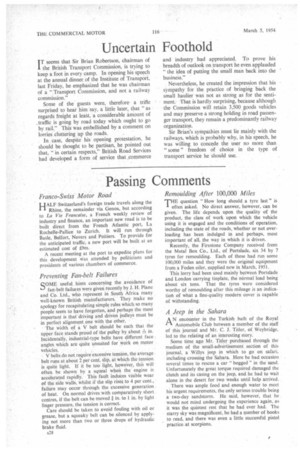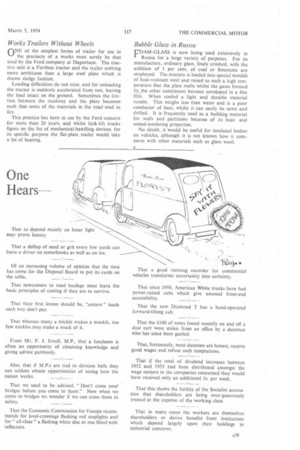Passing Comments
Page 30

Page 31

If you've noticed an error in this article please click here to report it so we can fix it.
Franco-Swiss' Motor Road
HALF Switzerland's foreign trade travels along the Rhine, the remainder via Genoa, but according to La Vie Francaise, a French weekly review of industry and finance, an important new road is to be built direct from the French Atlantic port, La Rochelle-Pallice to Zurich. It will run through Basle, Belfort, Nevers and Poitiers. To provide for the anticipated traffic, a new port will be built at an estimated cost of Om.
A recent meeting at the port to expedite plans for this development was attended by politicians and presidents of various chambers of commerce.
Preventing Fan-belt Failures
SOME useful hints concerning the avoidance of fan-helt failures were given recently by J. H. Plane and Co. Ltd., who represent in South Africa many, well-known British manufacturers. They make no apology for recapitulating simple rules which so many people seem to have forgotten, and perhaps the most important is that driving and driven Pulleys must be
in perfect alignment, one with the other.
The width of a V belt should be such that the upper face stands proud of the pulley by about 7Ir in. Incidentally, industrial-type belts have different face : angles which are quite unsuited for work on motor
vehicles. • •
V belts do not require excessive tension, the average. belt runs at about 2 per cent, slip, at which the tension is quite light. If it be too light, however, this wilt' often be shown by a squeal when the engine is accelerated rapidly. This fault induces visible wear of the side walls, whilst if the slip rises to 4 per cent., • failure may occur through the excessive generation ,
of heat. On normal drives with comparatively short. centres, if the belt can be moved 1 in. to 1 in. by light. finger pressure, the tension is correct. Care should be taken to avoid fouling with oil or grease, but a squeaky belt can be silenced by applying not more than two or three drops of hydraulic brake fluid.
A28
Remoulding After 100,000 Miles
'THE question "How long should a tyre last" is I often asked. No direct answer, however, can be given. The life depends upon the quality of the product, the class of work upon which the vehicle using it is engaged and the conditions of operation, including the state of the roads, whether or not overloading has been indulged in and perhaps, most important of all, the way in which it is driven.
Recently, the Firestone Company received from the Metal Box Co., Ltd., of Portslade, six 34 by 7 tyres for remoulding. Each of these had run some 100,000 miles and they were the original equipment from a Foden oiler, supplied new in March, 1951. This lorry had been used mainly between Portslade and London carrying tinplate, the normal load being about six tons. That the tyres were considered worthy of remoulding after this mileage is an indication of what a fine-quality modern cover is capable of withstanding.
A Jeep in the Sahara
AN encounter in the Turkish bath of the Royal Automobile Club between a member of the staff of this journal and Mr. C. J. Tiller, of. Weybridge. led to the relating of an interesting story. Some time. ago Mr. Titler purchased through the medium of the small-advertisement section of this journal, a Willys jeep in which to go on safari. including crossing the Sahara. ,Here he had occasion several times to rescue a car " bogged " in the sand. Unfortunately the great torque required damaged the clutch and its casing on the jeep, and he had to wait alone in the desert for two weeks until help arrived. There was ample food and enough water to meet his urgent requirements, the only serious trouble being a two-day sandstorm. He said, however, that he would not mind undergoing the experience again, as it was the quietest rest that he had ever had. The starry sky was magnificent, he had a number of books to read, and there was even a little successful pistol practice. at scorpions.
Works Trailers Without Wheels
0NE of the simplest forms of trailer for use in the precincts of a works must surely be that used by the Ford company at Dagenham. The tractive unit is a Fordson tractor and the trailer nothing more ambitious than a large steel plate which is drawn sledge fashion.
Loading difficulties do not exist, and for unloading the tractor is suddenly accelerated from rest, leaving the load intact on the ground. Sometimes the friction between the roadway and the plate becomes such that some of the materials in the road tend to fire.
This practice has been in use by the Ford concern for more than 20 years, and whilst fork-lift trucks figure on the list of mechanical-handling devices, for its specific purpose the flat-plate trailer would take a lot of beating.
Bubble Glass in Russia
FOAM-GLASS is now being used extensively in A Russia for a large variety of purposes. For its manufacture, ordinary glass, finely crushed, with the addition of 1 per cent. of coal or limestone are employed. The mixture is loaded into special moulds of heat-resistant steel and raised to such a high temperature that the glass melts whilst the gases formed by,the other constituent become enveloped in a fine film. When cooled a light and durable material results. This weighs less than water and is a poor conductor of heat, whilst it can easily be sawn and drilled. It is frequently used as a building material for walls and partitions because of its heatand sound-insulating properties.
No doubt, it would be useful for insulated bodies on vehicles, although it is not known how it compares with other materials such as glass wool,




































































































